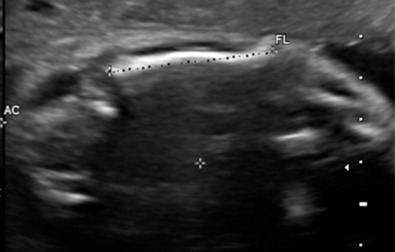Abstract
Diastrophic dysplasia (DTD) is an autosomal, recessively inherited skeletal dysplasia characterized by short limbs, normal-sized skull, cleft palate in one third of patients, characteristic swelling of the pinnae cartilage, contractures of the large joints with deformities, spinal abnormalities (scoliosis, exaggerated lumbar lordosis, cervical kyphosis), and a distinct brachydactyly associated with the characteristic hitchhiker thumbs. Ultrasound findings include shortened appendicular bones, scoliosis, deviated thumbs and halluxes, and micrognathia. DTD is caused by homozygosity or compound heterozygosity for mutations in the SLC26A2 gene; other allelic and more severe disorders include achondrogenesis type IB and atelosteogenesis type II.
Keywords
diastrophic dysplasia, SLC26A2 , autosomal recessive
Introduction
Diastrophic dysplasia (DTD) is an autosomal, recessively inherited skeletal dysplasia characterized by short limbs, normal-sized skull, cleft palate in one-third of patients, characteristic swelling of the pinnae cartilage, contractures of the large joints with deformities, spinal abnormalities (scoliosis, exaggerated lumbar lordosis, cervical kyphosis), and a distinct brachydactyly associated with the characteristic “hitchhiker” thumbs. Newborns with DTD have an increased risk of mortality in the neonatal period due to respiratory insufficiency (small rib cage, tracheal instability and collapsibility, and increased incidence of pneumonias), but most individuals with the condition live into adulthood and develop significant physical limitations.
DTD is caused by homozygosity or compound heterozygosity for mutations in the SLC26A2 gene. It is the only gene known to produce this disorder with no evidence for locus heterogeneity. Recessively inherited mutations in SLC26A2 can vary in severity from lethality to short stature associated with early onset osteoarthritis. From most to least severe, these conditions include achondrogenesis type IB, atelosteogenesis type II, and recessively inherited multiple epiphyseal dysplasia. There is a known genotype-phenotype correlation with mutations in the SLC262A gene; those mutations associated with the least amount of sulfate uptake in the cells are associated with more severe phenotypes.
Disorder
Definition
The term diastrophic dysplasia derives from the word diastrophism, the process of bending of the earth’s crust. Thus, the term refers to the manner in which the spine and limbs appear twisted in this disorder. The diagnosis is generally suspected by skeletal findings and physical features seen after birth, but DTD should be suspected prenatally when abnormalities are seen on ultrasound (US) examination or in the presence of a positive family history, particularly consanguinity. The diagnosis can be confirmed with prenatal or postnatal molecular genetic testing or postnatal radiologic findings.
Prevalence and Epidemiology
DTD is thought to occur in approximately 1 : 100,000 births, although specific prevalence data are unavailable. Although DTD is seen in all ethnic backgrounds, the condition is seen more often in individuals of Finnish descent (1 : 30,000). Individuals with DTD most often survive into adulthood and are often able to have children of their own.
Etiology, Pathophysiology, and Embryology
DTD is autosomal recessive in inheritance due to mutations in the SLC26A2 gene. Most of the mutations result in a loss of function of the gene. The severity of the diagnosis depends on the specific mutation present and its effects on the incorporation of sulfate into proteoglycans of the extracellular matrix of cartilage. Approximately 90% of individuals with a clinical diagnosis have an identifiable mutation; however, the most common SLC26A2 mutations account for nearly 65% of all cases. The four most common SLC26A2 pathogenic variants include p.Arg279Trp, c.–26+2T>C (IVS1+2T>C), p.Arg178Ter, and p.Cys653Ser and account for approximately 65% of disease alleles in diastrophic dysplasia. Although chromosomal rearrangements and deletions may be possible, they have not been reported to date.
In nearly all cases of DTD, both parents are unaffected carriers and recurrence risk to their offspring is 25%. To date, no de novo or germline mutations have been reported in this disorder. There is evidence that heterozygous mutations in the SLC26A2 can produce dysplastic spondylolysis, suggesting a new clinical disorder involving the lumbosacral spine.
Manifestations of Disease
Clinical Presentation
Nearly all individuals (95%) with DTD display proximal, abducted thumbs, resulting in a hitchhiker thumb appearance. Skeletal abnormalities often include shortened limbs, smaller than average chest, joint contractures, cervical kyphosis, and clubfeet. Less frequently, individuals with DTD have radial dislocation, tibial and radial bowing, and a gap between the first and second toes. Cleft palate is seen in approximately one-third of affected individuals. Additionally, neonatal swelling of the ears has been seen in approximately two-thirds of individuals with DTD and may lead to deformation of the ears.
For most individuals with DTD, intellect is normal; short stature, cervical spine instability, and joint contractures all are commonly observed. These individuals often require surgical repair of several abnormalities including cleft palate, clubfeet, and cervical spine instability.
Imaging Technique and Finding
Ultrasound.
Lethal and life-limiting skeletal dysplasias are frequently detected on routine prenatal US, but distinguishing among the various specific skeletal dysplasias is often difficult. DTD should be suspected in the case of several characteristic findings, including shortened long bones ( Fig. 49.1 ), twisting or bending of the spine ( Fig. 49.2 ), hitchhiker thumbs ( Fig. 49.3 ), and clubfeet. Experienced sonographers and perinatologists commonly are able to diagnose cases of DTD prenatally, but cases may go undetected until after birth. Three-dimensional or four-dimensional US is useful in the evaluation of fetuses with skeletal dysplasias, especially for imaging the face and extremities.











